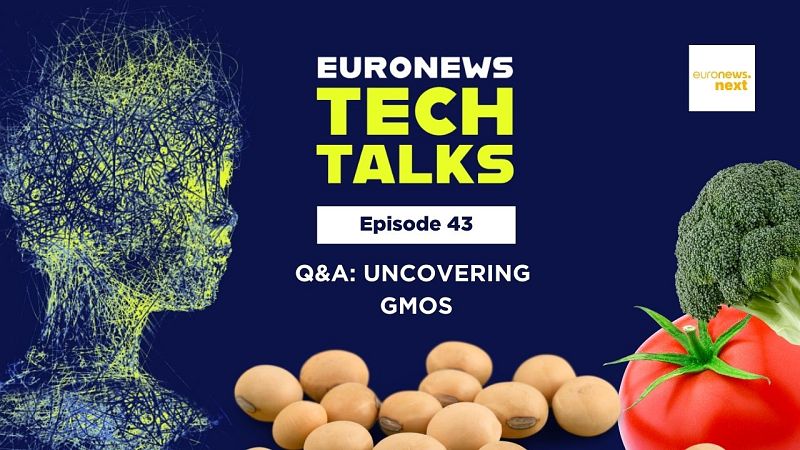What are GMOs and why do they remain so controversial? | Euronews Tech Talks

DNA is similar to a set of instructions written using four letters - A, T, C, and G - which tell the body how to function and develop.
These four letters form a unique combination for each organism, making each one unique.
A segment of DNA is called a gene, while the entire set of DNA instructions contained in a cell is a genome.
Even before the discovery of genetics in the 19th century, scientists have tried to alter these sets of instructions to enhance crop resistance, improve medical treatments, and address health issues.
However, the safety and ethics behind these genetically altered or modified organisms (GMOs), particularly in terms of crops, remain debated across the globe, especially in the European Union.
To better understand what GMOs are and how they work, Euronews Tech Talks collected questions from its audience and asked them to Josep Casacuberta, a physics researcher at the Centre for Research in Agricultural Genomics in Barcelona and the chair of the genetically modified organism (GMO) panel of the European Food Safety Authority (EFSA).
Here's what he had to say.
What are GMOs and why do they exist?
According to the EU, a GMO is by definition "an organism, with the exception of human beings, in which the genetic material has been altered in a way that does not occur naturally by mating and/or natural recombination".
Casacuberta explained that, until very recently, GMOs were essentially transgenic. In other words, an artificial gene had been introduced to the organism.
But now new techniques have recently emerged which consist of directly modifying an organism’s DNA, without inserting new external genes.
These techniques gave rise to what is known as the new generation of GMOs, or new genomics techniques (NGTs).
The first steps in genetic engineering were taken in 1973 by US biochemists Herbert Boyer and Stanley Cohen, who inserted DNA from one bacterium into another.
However, Casacuberta pointed out that humans have been trying to modify the genomes of plants and animals for centuries, aiming to create new varieties that are better suited to our needs.
Even some of the food we consume today is the result of selective breeding. Broccoli, for instance, derives from Brassica Oleracea, also known as wild cabbage.
The plant was originally edible but bitter, so farmers selected and replanted seeds with a sweeter taste to gradually emphasise this trait.
Casacuberta considers GMOs as an additional newer technique that can be used by farmers to change crops’ characteristics, adapting to changing climates and extreme weather.
"We are trying to obtain food in a way that has less impact on the environment. For example, using less water, using less inputs in terms of, for example, pesticides and herbicides, etc. And to do that, we need better varieties adapted to this type of agriculture," the researcher said.
GMO production globally vs in the EU
In 2023, the United States was the world’s leading producer of GMOs, with 74.4 million hectares dedicated to GM crops; Brazil followed with 66.9 million hectares and Argentina with 23.1 million.
By contrast, Europe held a very limited area of GM cultivation, with a little over 48,000 hectares dedicated to these crops in 2023.
The majority of this is concentrated in Spain, where over 95 per cent of the European GM cultivation takes place.
MON 810 maize is the only GM crop approved for commercial cultivation in the EU.
Several EU countries like France and Germany have banned the cultivation of GMOs over concerns about the environmental impact and health risks of these crops. However, they are not GMO-free.
Despite the national bans on the cultivation of GMOs for food, EU countries import GMOs to meet domestic requirements in animal feed, like GM soybeans.
Casacuberta explained the current situation of GMO production in the EU saying, "because Europe has not approved any other GMO for cultivation since a very long time ago, companies are not even asking for authorisation for cultivation".
Health implication of GMOs
"GMO is just a technique," said Casacuberta about the risk assessment for GMOs.
He explained that it is merely a procedure followed to introduce a desired trait to an organism, and each organism developed is different from the other. Hence, risk assessment has to be done on a case-by-case basis.
EFSA is the EU agency charged with assessing risks deriving from GMOs related to human and animal health and the environment in Europe.
"What we assess at EFSA when there is a GMO that wants to get the approval for is if this GMO is safe for consumption for humans and consumption for animals," Casacuberta told Euronews.
The scientist also added that EFSA conducts thorough analyses of the new traits introduced in a GMO before moving onto the discussion on its commercialisation.
"So, what we can say is that all the GMOs that are commercialised in Europe are safe," he asserted.
Despite EFSA’s safety measures, GMOs continue to spark controversy.
On the one hand, we can see the difference between the scientific perspective and the public opinion.
For instance, a 2021 survey conducted in Italy revealed that 81 per cent of a sample of the Italian agricultural scientists believe that GMOs are generally safe to eat, whereas only 54 per cent of the Italian general public believes the same.
On the other hand, despite this scientific tendency in favour of GMOs, the scientific community is still divided.
In 2024, 34 Nobel Prize winners called on the EU in an open letter to ease its policy on genetic modifications and to allow scientists to develop GM crops that can withstand the climate crisis.
Yet, organisations like the European Network of Scientists for Social and Environmental Responsibility (ENSSER) are more critical of GMOs impact on biodiversity and human health.
Today







